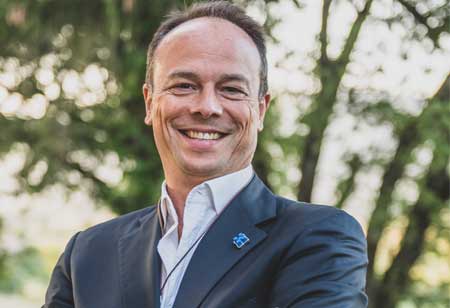

Thank you for Subscribing to Environmental Business Review Weekly Brief

Marco Guazzoni, Director of Sustainability at Vibram Group, combines his experience, which spans over two decades, to innovate and turn sustainable development goals into measurable actions. Guazzoni lives by the motto “Be the change you want to see” to ensure sustainability in footwear component manufacturing. He inspires industry leaders with extensive experience in executive leadership, covering everything from strategic planning to process optimization and profit maximization.
In an interview with Manufacturing Outlook Europe, Guazzoni discusses transforming Vibram's sustainability development goals and plans into strategic actions and outcomes. Can you elaborate on your journey in the industry? I started working at Vibram 10 years ago as R&D Director and went on to become the director of sustainability. I'm responsible for the strategy and creation of an actual Sustainability strategic plan, propelling every function in the company to move towards sustainability. We analyze the process and product, and the impact that we have on the environment, the people and the economics to mitigate it without compromising on performance. Reducing energy consumption and waste are the two major pillars of sustainability that can help in mitigating adverse impacts on the environment. Encouraging and recognizing the engagement of our employees and stakeholders in ensuring sustainability, supply chain control, product and process innovation, and the governance of the company internally are the factors that I focus on. What are the challenges in the sustainable manufacturing industry? Cultivating a mindset of considering the planet a shareholder of the company is a major challenge. If we take any resource from nature, we should also be able to give back. We refrain from draining the resources as much as possible. While ensuring excellent product quality for our customers' safety, we are committed to our planet's protection. “To achieve sustainability, a long-term plan has to be devised and it should be profitable as well. This helps efficiently manage the material, energy and the time spent by people involved in production.” What are the challenges prevailing in the industry? We consistently evaluate our processes to understand the adverse impact on the environment and prioritize the solution we need to bring in order to reduce it. For example, we made the first life cycle assessment for a sole and registered the standard methodology. We identified that some of our materials and production processes contributed to resource depletion. To manage this, we designed a plan to reduce waste. We give great importance to energy consumption and try to utilize renewable energy resources in our production process. When we cannot completely switch to renewable resources, we focus on reducing industrial waste by using recyclable materials to strike an ecological balance. Where applicable we reuse our industrial waste and try to be more circular in our processes. Collaborating with other companies in or outside our supply chain is crucial in reducing the carbon footprint. As a leader in the market, we want to share our insights with the world by being the voice of experts at the European Communities and the United Nations. With Monitor For Circular Fashion we want to incorporate the ideas of the United Nations and similar organizations to drive the industry in the right direction. The concern is to reach this goal without negatively affecting the industry, the fashion industry in Italy accounts for 12 percent of our GDP. The legislators capable of bringing change can include industry experts to educate the market in increasing production without causing destruction to the planet. We also collaborate with MIT, where we formulate solutions to minimize the impact on the sneaker production. How do you envision the future of the industry? In the future, there will be more collaboration and more transparency even on the value of every step of the value chain because we will go in the direction of recognizing the value of everybody and giving the profits and value back to everybody. At this early stage, there is still the mentality of real competition, but eventually, we will learn to be more collaborative. Sustainability is not competition; it is collaboration. There will also be transparency and traceability in the legislation in all sectors. Technology tools like blockchain, as an ecological instrument, can help move to a seamless process of working. Transparency regarding the processes will be ensured while containing certain information within an organization. We need to move toward customization and made-to-order processes to reduce overstocking and reduce wastage. Manufacture products only on demand could be a big improvement. What is your piece of advice to the budding professionals in the industry? To achieve sustainability, a long-term plan has to be devised and it should be profitable as well. This helps efficiently manage the material, energy and the time spent by people involved in production. To bring a real change, we need to give knowledge about sustainability to the whole company. Engage all the employees of the company in learning more about sustainability. Having the millennial generation come into the company to engage all generation can be useful because they are very sensible about sustainability. They might have less experience, but they can bring new perspectives, opportunities, and ideas to make changes and do things correctly to ensure internal sustainability. Consistency can go a long way in building a sustainable community of professionals.